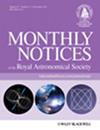利用拉斯坎布雷斯天文台有针对性地搜索强透镜超新星
IF 4.8
3区 物理与天体物理
Q1 ASTRONOMY & ASTROPHYSICS
引用次数: 0
摘要
引力透镜超新星(glSNe)对时延宇宙学和SN物理学很有意义。然而,由于SN爆炸本身的稀有性、与前景透镜对齐的必要性以及相对较短的可探测窗口期,glSNe的探测非常罕见。我们提出了 "拉斯坎布雷斯天文台透镜超新星搜索"(LCOLSS),这是一项旨在探测已知强透镜系统中的glSNe的目标巡天。利用r′波段成像,LCOLSS根据估计的恒星形成率,锁定了114个具有高预期超新星发生率的星系-星系透镜系统。在为期两年的观测计划中,LCOLSS没有探测到任何可信的GlSN。我们在此进行分析,测量这些观测的探测效率。然后,我们利用预测的超新星率进行蒙特卡罗模拟,以确定预期探测到的glSN数量。模拟结果表明,所有的SNE、Ia型SNE和核坍缩(CC)SNE的预期探测数和68%的泊松置信区间分别为:NSN = 0.20, [0, 2.1],NIa = 0.08, [0, 2.0],NCC = 0.12, [0, 2.0]。这些结果与我们的巡天中没有发现的情况基本一致。对巡天策略的分析可以为今后制定有针对性的glSN发现计划提供启示,特别是考虑到即将进行的巡天的预期产量很大。本文章由计算机程序翻译,如有差异,请以英文原文为准。
A targeted search for strongly lensed supernovae with the Las Cumbres Observatory
Gravitationally lensed supernovae (glSNe) are of interest for time delay cosmology and SN physics. However, glSNe detections are rare, owing to the intrinsic rarity of SN explosions, the necessity of alignment with a foreground lens, and the relatively short window of detectability. We present the Las Cumbres Observatory Lensed Supernova Search, LCOLSS, a targeted survey designed for detecting glSNe in known strong lensing systems. Using cadenced r′-band imaging, LCOLSS targeted 114 galaxy-galaxy lensing systems with high expected SN rates, based on estimated star formation rates. No plausible glSN was detected by LCOLSS during our two year observing program. We carry out an analysis here to measure a detection efficiency for these observations. We then perform Monte Carlo simulations using the predicted supernova rates to determine the expected number of glSN detections. The results of the simulation suggest an expected number of detections and $68\%$ Poisson confidence intervals, NSN = 0.20, [0, 2.1], NIa = 0.08, [0, 2.0], NCC = 0.12, [0, 2.0], for all SNe, Type Ia SNe, and core-collapse (CC) SNe respectively. These results are broadly consistent with the absence of a detection in our survey. Analysis of the survey strategy can provide insights for future efforts to develop targeted glSN discovery programs, especially considering the large anticipated yields of upcoming surveys.
求助全文
通过发布文献求助,成功后即可免费获取论文全文。
去求助
来源期刊

Monthly Notices of the Royal Astronomical Society
ASTRONOMY & ASTROPHYSICS-
CiteScore
9.10
自引率
37.50%
发文量
3198
审稿时长
3 months
期刊介绍:
Monthly Notices of the Royal Astronomical Society is one of the world''s leading primary research journals in astronomy and astrophysics, as well as one of the longest established. It publishes the results of original research in positional and dynamical astronomy, astrophysics, radio astronomy, cosmology, space research and the design of astronomical instruments.
 求助内容:
求助内容: 应助结果提醒方式:
应助结果提醒方式:


